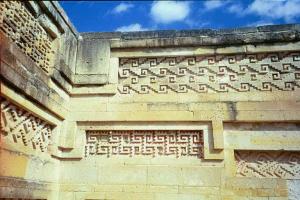On Wednesday, we hired a guide named Nicolas to show us more of the Oaxaca area. He decided to take us to visit the Mitla Ruins, one of the less-visited archaeological sites in the area. Despite the beauty of the area and the ruins in particular, we were getting a little tired of always having our guides take us to see ruins. Those sites might be a major tourist draw, and the history is interesting, but I want to learn more about modern-day Mexico, not about how people lived a thousand or more years ago.
Mitla was occupied by both the Zapotec and Mixtec peoples, at different points in history. People may have lived in Mitla as early as 900 B.C., but the structures that are there today date back to about 200 A.D. At that time, until about 1000 A.D., the Zapotecs controlled Mitla. Then, for a few hundred years, the Mixtecs took over. There’s mixed information about when the Zapotecs reclaimed Mitla; some sources say it was around 1200 A.D., while others say it wasn’t until about 1500.
The research and excavations done on Mitla reveal that the site was used for burials during both Mixtec and Zapotec times. The name “Mitla” translates to “Place of the Dead,” and the original Zapotec name for the city was Lyobaa, which translates to “Place of Rest,” reinforcing the findings of the archaeologists.
One of the most fascinating structures in Mitla is now called the Hall of Columns. Archaeologists aren’t sure what the original name of the building was. The hall itself leads into a large, windowless chamber, which now doesn’t have a roof but did originally. The chamber walls have intricate mosaics, some of which appear to show Quetzalcoatl, the feathered serpent deity worshipped by many of the ancient residents of the area.
Archaeologists aren’t entirely sure what the chamber was used for. In the late 1500s, a Spanish explorer wrote that the residents of Mitla worshipped idols and performed sacrifices in the Hall of Columns, and that the high priest lived in the chamber. But an ancient legend implies that the chamber was used for initiation rites for shamans who trained in Mitla.
A somewhat frightening piece of Mitla is a large column near the Hall of Columns. This column, the Pillar of Death, is on what’s known as the Patio of Tombs, and legend has it that if someone puts their arms around the column and feels it move, they’re about to die.
Even though ancient history doesn’t have anything to do with my book, it is intriguing to learn some of these things.
 |
| Here's a fence made entirely from planted cacti! |




